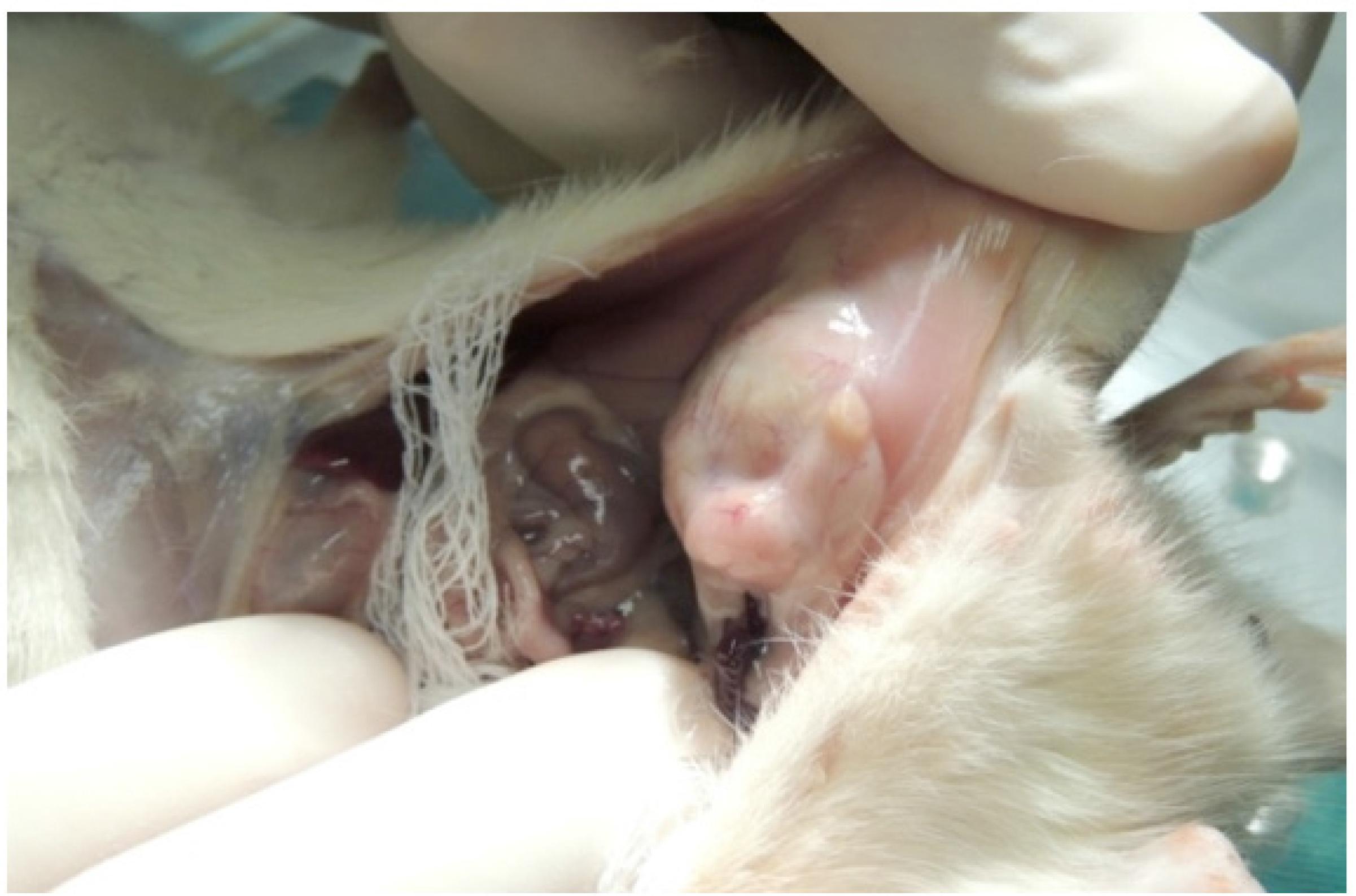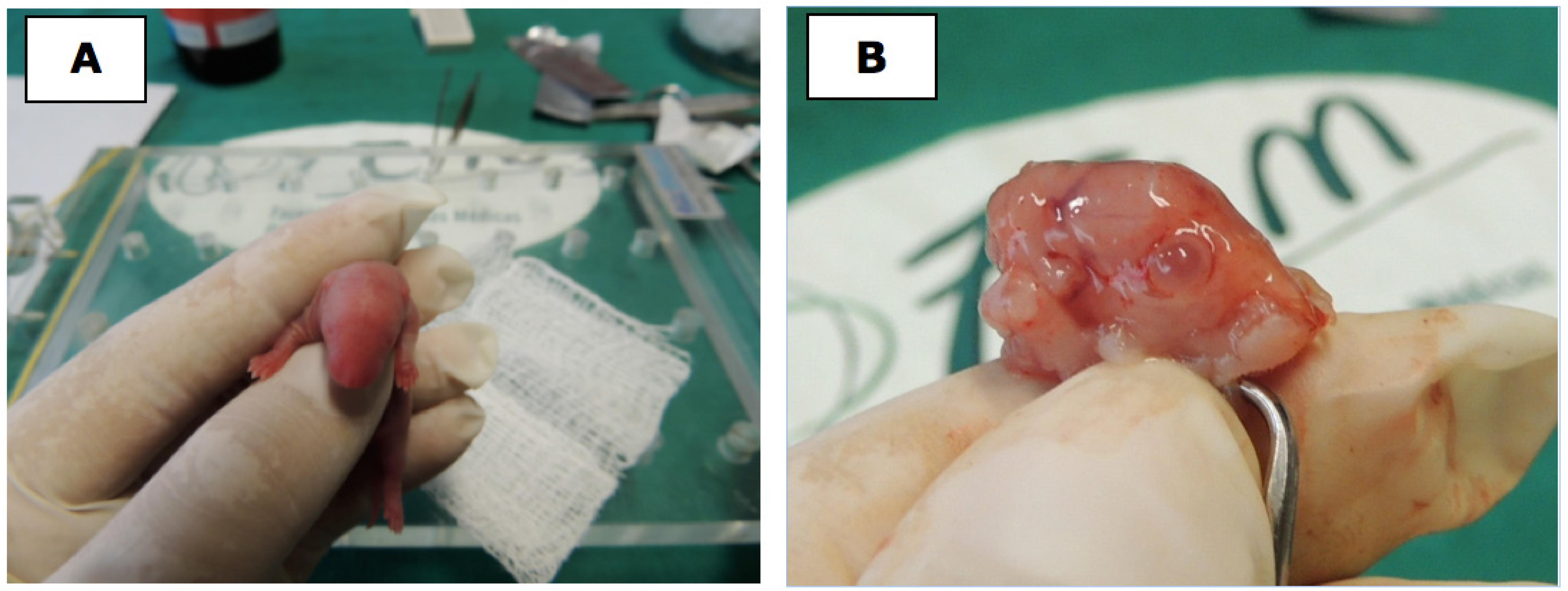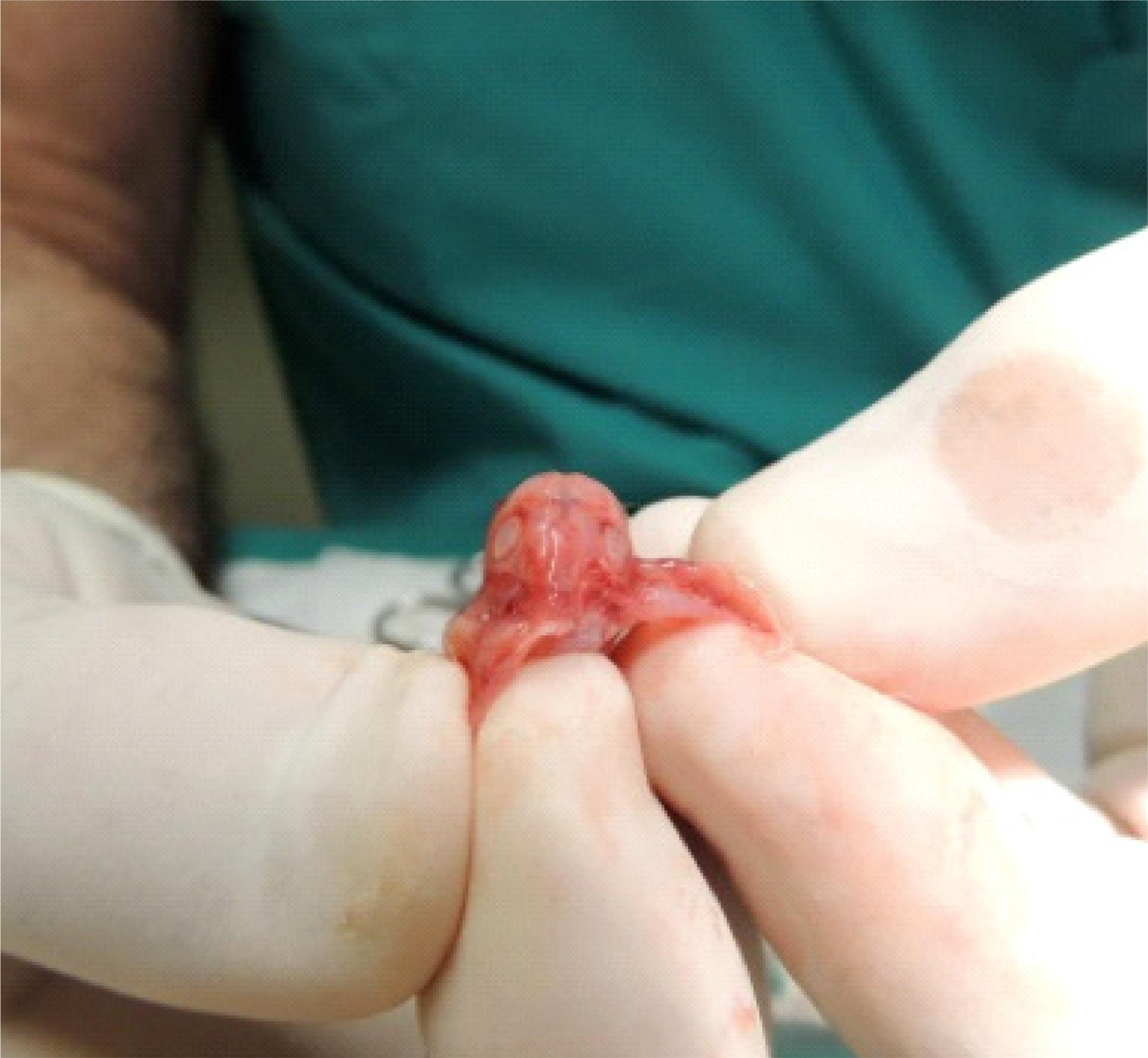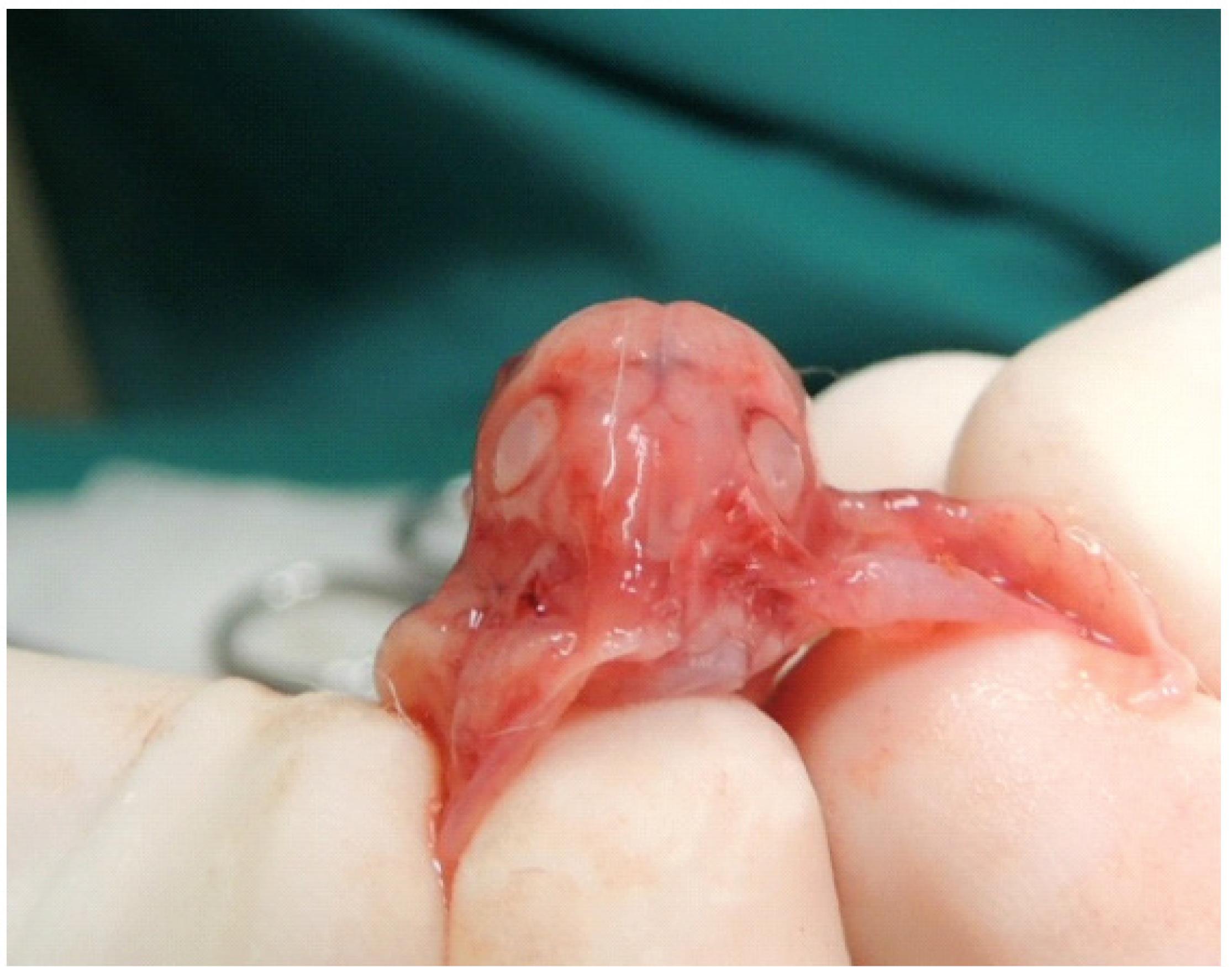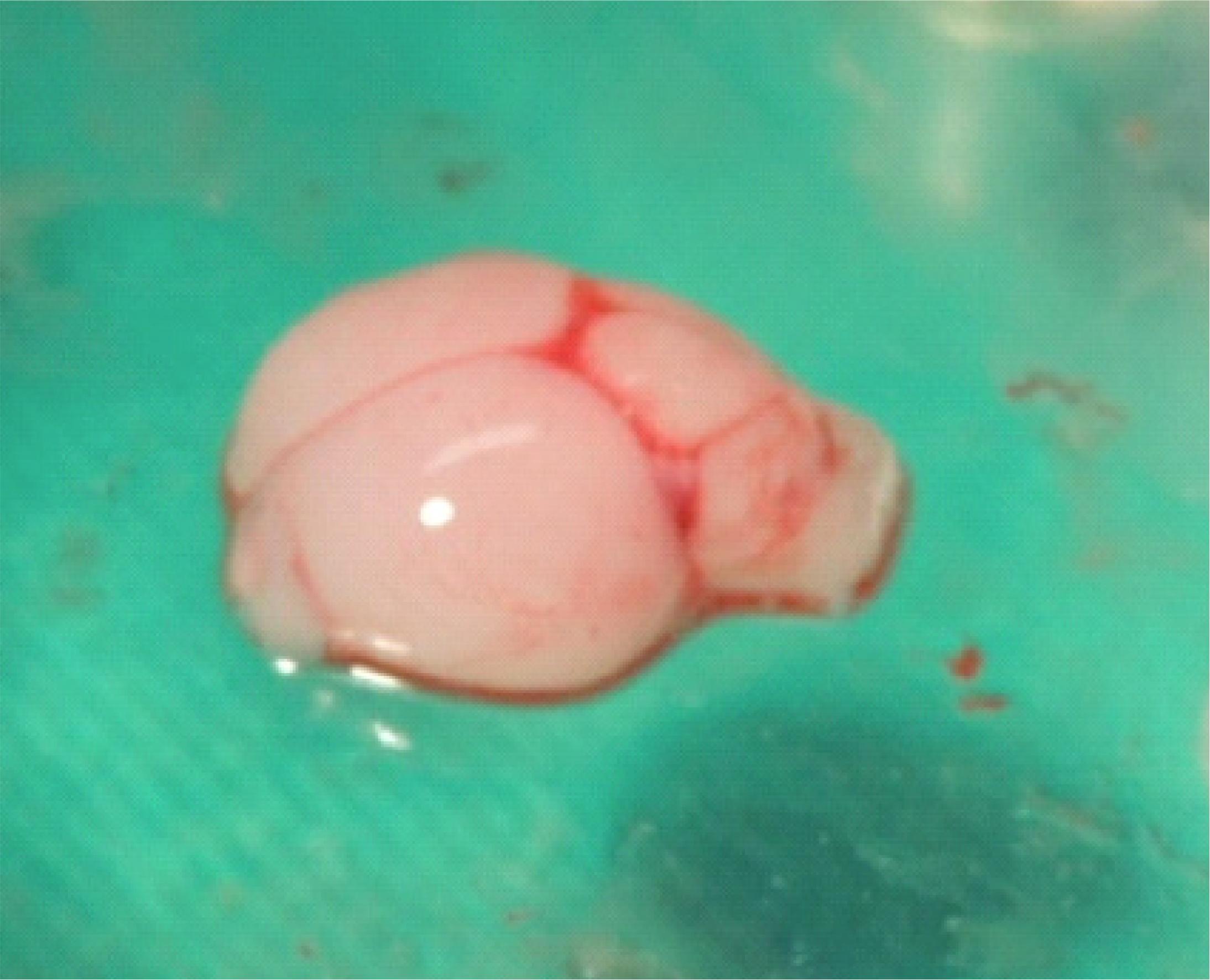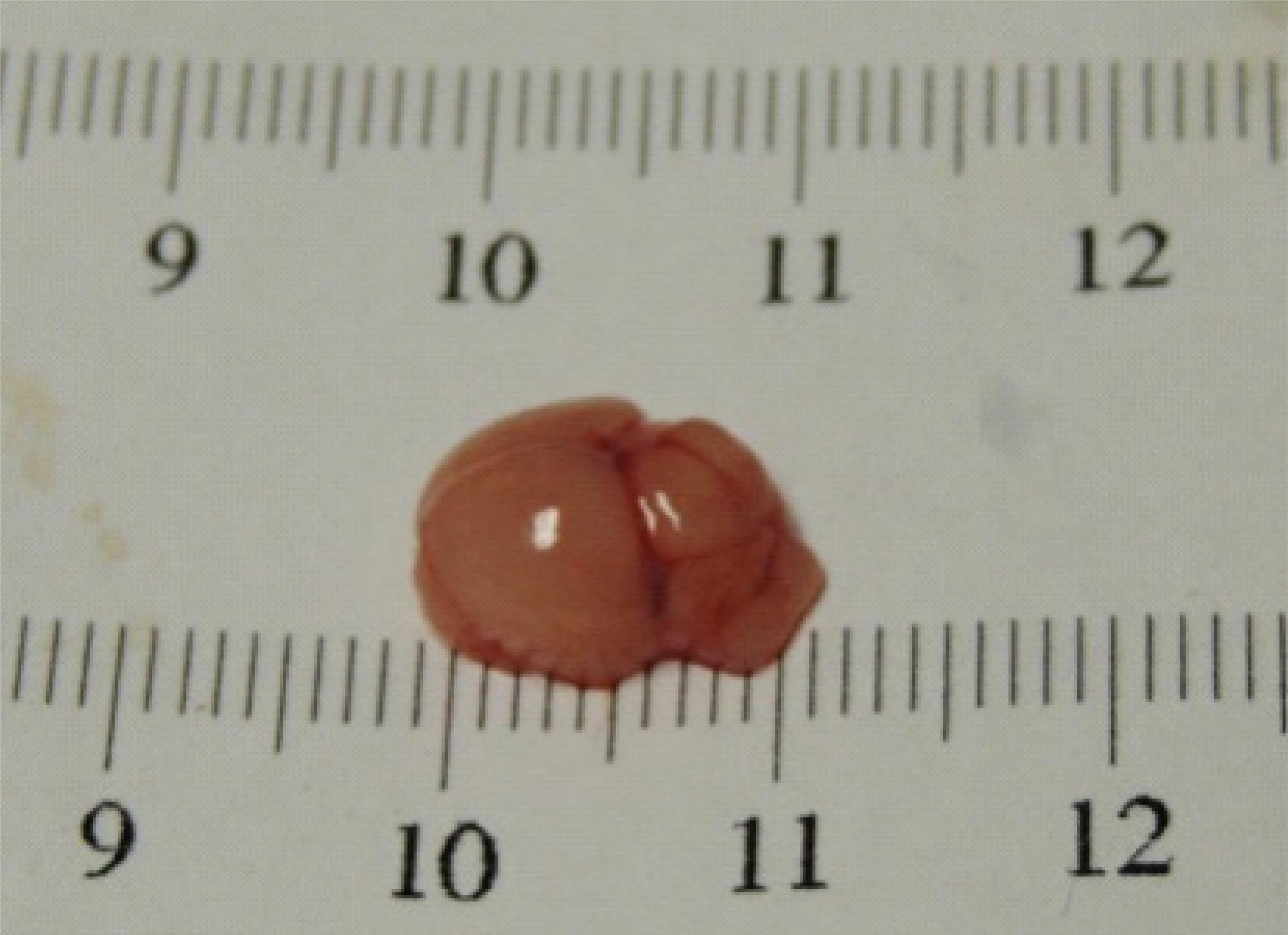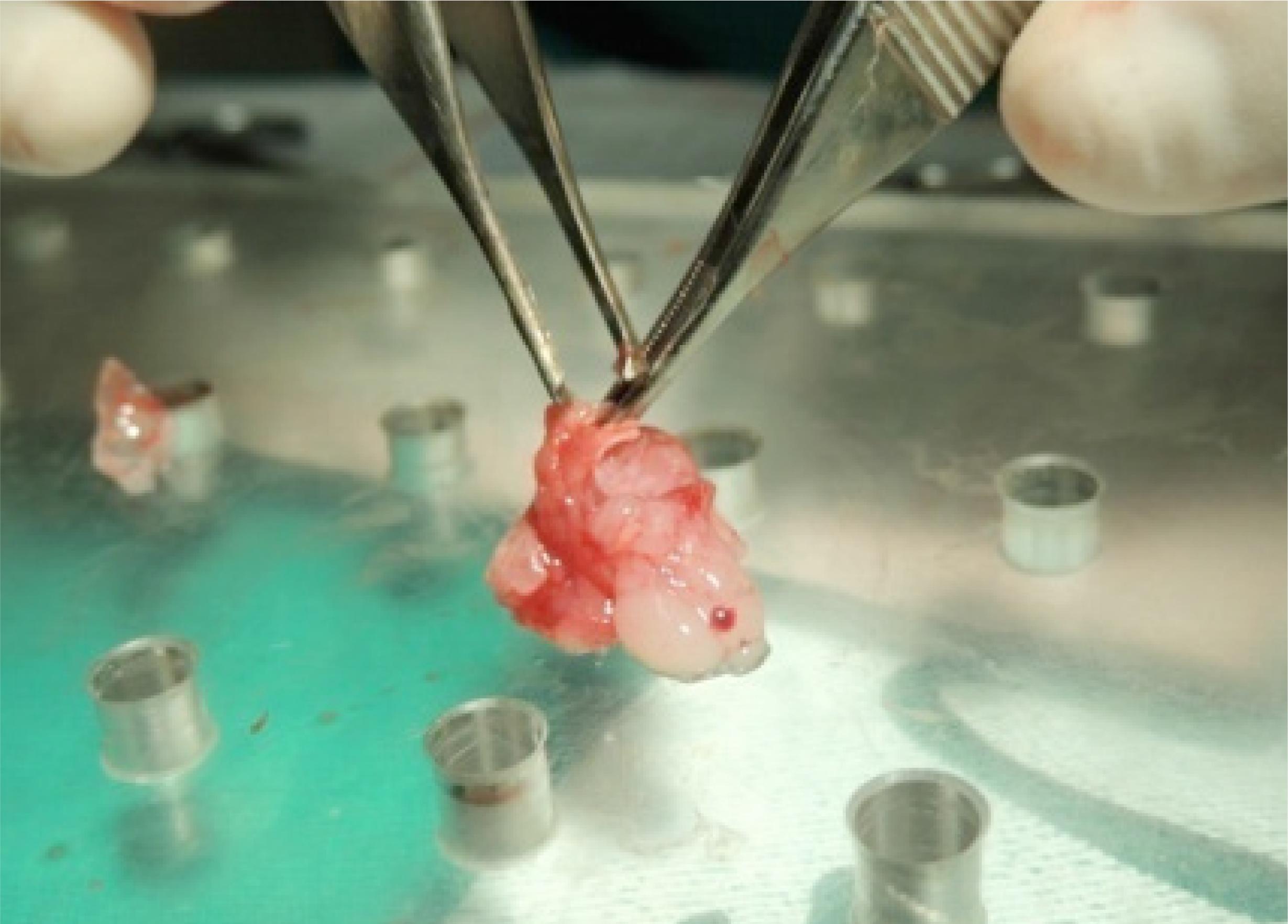Abstract
PURPOSE:
To investigate the morphological aspects of brain and eyes in newborn rats whose mother underwent autogenously fecal peritonitis.
METHODS:
Four pregnant rats that underwent fecal peritonitis, with a 10% fecal suspension in dose of 4 ml per kilogram received two antimicrobial treatments: 1. intraperitoneal moxifloxacin and dexamethazone; and 2. Intravenous meropenem. After head inspection, the brain consistencies and the eyes belonging to all offspring were analyzed.
RESULTS:
The brains of newborn from rats that received 4 ml/kg of 10% suspension of feces showed, significantly smaller and less than the firm consistency of those in the control group. Congenital cataract was observed in 9 (34.6%). No cataract was observed in the 20 newborn rats from the mothers that received the combination of moxifloxacin and dexamethasone. Cataract could be observed in three (13.6%) offspring from mothers that received meropenem.
CONCLUSIONS:
Peritonitis can produce brain damage and congenital cataract in rats. The translation to humans is that intra abdominal infection in pregnant women may be associated with damage in brain and eye structures of their concepts. This can be averting using the adequate early therapeutically approach.
Peritonitis; Quinolones; Carbapenems; Cataract; Rats
Introduction
The most important treatable cause of childhood remains untreated or poorly treated
cataract, which is responsible for 5-20% of all cases, although corneal scarring can
present similar or even higher prevalence in some countries11. Foster A, Gilbert C, Johnson G. Changing patterns in global
blindness: 1988-2008. Community Eye Health. 2008 Sep;21(67):37-9. PMID:
19030126.
2. Ono K, Hiratsuka Y, Murakami A. Global inequality in eye health:
country-level analysis from the Global Burden of Disease Study. Am J Public Health.
2010 Sep;100(9):1784-8. doi: 10.2105/AJPH.2009.187930.
https://doi.org/10.2105/AJPH.2009.187930...
-
33. Churchill A, Graw J. Clinical and experimental advances in congenital
and paediatrics cataracts. Phil Trans R Soc. 2011 Apr;366:1234-49. doi:
10.1098/rstb.2010.0227.
https://doi.org/10.1098/rstb.2010.0227...
.It can be diagnosing at birth or shortly
thereafter, or even it develops during the first two years of life44. Yorston D, Wood M, Foster A. Results of cataract surgery in young
children in east Africa. Br J Ophthalmol. 2001 Mar;85:267-71. doi:
10.1136/bjo.85.3.267.
https://doi.org/10.1136/bjo.85.3.267...
5. Mwende J, Bronsard A, Mosha M, Bowman R, Geneau R, Courtright P.
Delay in presentation to hospital for surgery for congenital and developmental
cataract in Tanzania. Br J Ophthalmol. 2005 Nov;89(11):1478-82. doi:
10.1136/bjo.2005.074146.
https://doi.org/10.1136/bjo.2005.074146...
-
66. Randrianotahina HC, Nkumbe HE. Pediatric cataract surgery in
Madagascar. Niger J Clin Pract. 2014 Jan-Feb;17(1):14-7. doi:
10.4103/1119-3077.122824.
https://doi.org/10.4103/1119-3077.122824...
.
Among the causes of human congenital cataract are intrauterine infections
(toxoplasmosis, rubella, cytomegalovirus, herpes, varicella and syphilis).Worldwide, it
is estimated that more than 100 000 infants are born with congenital rubella syndrome
(CRS) each year, and the burden in developing countries is very high. Congenital
cataract is one of the corn stone of this syndrome77. Robertson SE, Featherstone DA, Gacic-Dobo M, Hersh BS. Rubella and
congenital rubella syndrome: global update. Rev Panam Salud Publica. 2003
Nov;14:306-15. doi.org/10.1590/S1020-49892003001000005.
https://doi.org/10.1590/S1020-4989200300...
,
88. Dewan P, Gupta P. Burden of Congenital Rubella Syndrome (CRS) in
India: a systematic review. Indian Pediatr. 2012 May;49(5):377-99. doi:
10.1007/s13312-012-0087-4.
https://doi.org/10.1007/s13312-012-0087-...
. However, the majority of cataracts in newborns
are genetically caused99. Shiels A, Bennett TM, Knopf HL, Maraini G, Li A. The EPHA2gene is
associated with cataracts linked to chromosome 1p. Mol Vis. 2008 Nov;14:2042-55.
PMID: PMC2582197.
10. Zhang T, Hua R, Xiao W, Burdon KP, Bhattacharya SS. Mutations of the
EPHA2 receptor tyrosine kinase gene cause autosomal dominant congenital cataract. Hum
Mutat. 2009 Mar;30:E603-11. doi: 10.1002/humu.20995.
https://doi.org/10.1002/humu.20995...
-
1111. Dave A, Laurie K, Staffieri SE, Taranath D, Mackey DA, Mitchell P,
Wang JJ, Craig JE, Burdon KP, Sharma S. Mutations in the EPHA2 gene are a major
contributor to inherited cataracts in South-Eastern Australia. PLoS One. 2013
Aug;8(8):e72518. doi: 10.1371/journal.pone.0072518.
https://doi.org/10.1371/journal.pone.007...
.The mutations in structurally and functionally
important genes such as EPHA2 in the lens may contribute to a significant proportion of
the congenital cataract burden1212. Prakalapakorn SG, Rasmussen SA, Lambert SR, Honein MA. National
Birth Defects Prevention. Study Assessment of risk factors for infantile cataracts
using a case-control study: National Birth Defects Prevention Study, 2000-2004.
Ophthalmology. 2010 Aug;117(8):1500-5. doi:
10.1016/j.ophtha.2009.12.026.
https://doi.org/10.1016/j.ophtha.2009.12...
. There have been
other suggestions of a possible association between pregnancy events and congenital
cataracts, including: very low birth weight; maternal substance abuse; urinary tract
infection; and aspirin ingestion1212. Prakalapakorn SG, Rasmussen SA, Lambert SR, Honein MA. National
Birth Defects Prevention. Study Assessment of risk factors for infantile cataracts
using a case-control study: National Birth Defects Prevention Study, 2000-2004.
Ophthalmology. 2010 Aug;117(8):1500-5. doi:
10.1016/j.ophtha.2009.12.026.
https://doi.org/10.1016/j.ophtha.2009.12...
.
As regard to experimental model of this disease, it is well recognized that congenital
cataract is present in over 45% of the offspring of diabetic rats1313. Simán CM, Naeser P, Eriksson UJ. Increased lenticular aldose
reductase activity and high incidence of congenital cataract in the offspring of
diabetic rats. Acta Ophthalmol (Copenh). 1993 May;71(5):629-36. doi:
10.1111/j.1755-3768.1993.tb04652.x.
https://doi.org/10.1111/j.1755-3768.1993...
. Pregnant rats with hypercholesterolemia can also have pups with
congenital cataract1414. El-Sayyad HI, El-Sherbiny MA, Sobh MA, Abou-El-Naga AM, Ibrahim MA,
Mousa SA. Protective effects of Morus alba leaves extract on ocular functions of pups
from diabetic and hypercholesterolemic mother rats. Int J Biol Sci. 2011
Jun;7(6):715-28. PMID: PMC3119844.. Additionally, excessive
maternal caffeine exposure during pregnancy can be cataractogenic for neonatal
crystalline lenses in these animals1515. Evereklioglu C, Güldar E, Alasehirli B, Cengiz B, Sari I, Pirbudak
L. Excessive maternal caffeine exposure during pregnancy is cataractogenic for
neonatal crystalline lenses in rats: a biomicroscopic and histopathologic study. Acta
Ophthalmol Scand. 2004 Sep;82(5):552-6. doi:
10.1111/j.1600-0420.2004.00331.x.
https://doi.org/10.1111/j.1600-0420.2004...
.
Several mouse models of congenital cataract have genetic basis as exemplified by the
following: (i) the most frequent mutations in congenital cataracts affect genes coding
for γ-crystallins (gene symbol: Cryg); (ii) some postnatal, progressive cataracts have
been characterized by mutations in the ß-crystallin encoding genes (Cryb); (iii)
mutations in genes coding for membrane proteins like MIP or connexins lead to congenital
cataracts; (iv) mutations in genes coding for transcription factors such as FoxE3, Maf,
Sox1,andSix5 cause cataracts; (v) mouse models suffering from hereditary age-related
cataracts have not yet been characterized genetically1616. Graw J. Mouse models of cataract. J Genet. 2009 Dec;88(4):469-86.
doi: org/10.1007/s12041-010-0004-3.
https://doi.org/10.1007/s12041-010-0004-...
. It has also been described a mouse mutantAca47 that carries a missense
mutation in the Lim2 gene (c.T151C; p.C51R) that leads to decreased sizes of eye axis
and lens. Since homozygous mutants further develop congenital lens opacities, Aca47
might be used as a model for congenital cataract formation in humans1717. Puk O, Ahmad N, Wagner S, de Angelis MH, Graw J. Microphakia and
congenital cataract formation in a novel Lim2(C51R) mutant mouse. Mol Vis. 2011
May;17:1164-71. PMID: PMC3102026..
Gram-negative urinary tract infections can complicate human pregnancies. However, the
effects of maternal endotoxemia from these microorganisms have rarely been evaluated by
animal experiments or by human investigations. The main affected area from this
aggression is the central nervous system1818. Ornoy A, Altshuler G. Maternal endotoxemia, fetal anomalies, and
central nervous system damage: a rat model of a human problem. Am J Obstet Gynecol.
1976;124(2):196-204. PMID:1108657..
Neuroinflammation can sensitize the brain to injurious insults in the embryonic
development and produces several anomalies in this system, however not specifically in
the eye embryology this injury has been described1919. Malaeb S, Dammann O. Fetal inflammatory response and brain injury in
the preterm newborn. J Child Neurol. 2009 Sep;24(9):1119-26. doi:
10.1177/0883073809338066.
https://doi.org/10.1177/0883073809338066...
. On the other hand, autoimmune optic neuritis is a common early
manifestation of multiple sclerosis, yet early therapeutic interventions for this
disease often have high ocular toxicity associated with increased risks for glaucoma,
cataract, or retinopathy. This phenomenon can be studied in rat model2020. Stokely ME, Bhat MA, Koulen P. Microfluorimetry defines early axonal
damage in a rat model of optic neuritis: a novel method targeting early CNS
autoimmunity. J Neurosci Methods. 2007 Nov;166(2):217-28. doi:
org/10.1016/j.jneumeth.2007.07.010.
https://doi.org/10.1016/j.jneumeth.2007....
.
To the best of our knowledge there is no experimental rat model associating bacterial peritonitis and congenital cataract. Thus, the purpose of this study is to report the occurrence of this congenital anomaly in newborn rats from mothers that underwent autogenously fecal peritonitis early in pregnancy; and also to show two antimicrobial treatments for sepsis and their effects in the prevention of this condition.
Methods
This was a prospective and interventional study and all experiments were conducted in accordance with the national laws for the use of animals in research and approved by the local Ethical Committee at Medical School from Campina Grande - Paraiba, Brazil.
The study design was threefold: 1st: To develop a model of autogenously fecal peritonitis in pregnant rats in a way to produce significant brain damage in the offspring. With this aim it was injected into the abdominal cavity 3ml/kg and 4ml/kg of autogenously filtered 10% fecal suspensions in two groups of 10 animals each at the 9th day of proved pregnancy. After pup birth the female adult rats underwent abdominal and thorax inventory for assessing the findings associate with the peritonitis. The weights of the offspring and their brain were recorded. The morphological aspects of the newborn animals were also described, with special attention to the head structures and the central neural system. Ten animals without any intervention were used as a control group.
2nd: After concluding that the most damaging model for the central nervous system was the injection into the peritoneal cavity of 4ml/kg of filtered 10% fecal suspension at the 9th day of proved pregnancy, two rats with autogenously peritonitis were treated with the combination of moxifloxacin and dexamethasone at the single intra-peritoneal doses of 40mg/kg and 0.2mg/kg, respectively. Both drugs were given at 48 h and 72 h after peritonitis induction.
3rd: Using the same model two pregnant rats as the above mentioned protocol received a single doses of meropenen 60 mg/kg/d i.v at 48 h and 72 h after peritonitis induction.
Since after birth the offspring were separated from their mothers and inspected for any congenital malformation and weighed in a precise scale. They were euthanized by halothane and decapitated. After close morphological inspection, the brains were carefully removed and equally weighed.
The quantitative parameters were expressed by their mean and standard deviation. As the parameters did not pass the normality test, the following statistical analyses were used: the Mann-Witney test for unpaired mean differences, the Kruskal-Wallis test and the post-test of Dunn for multi comparisons among means. p≤0.05 was used for rejecting the null hypothesis.
Results
After delivery the two groups of rats were euthanized and the abdomen and thorax were widely open for inspection, and pictures were taken for recording the lesions. The multiple infected lesions, inside both cavities, were more frequent and evident in their aggressiveness appearance into the pregnant rats that received 4ml/kg of autogenously filtered 10% fecal suspensions when compared with those that received 3ml/kg (Figures 1-4).
FIGURE 1 -Residual retroperitoneal abscess in the left lateral abdominal wall close by the left kidney could be observed. The pregnant rat had received 4ml/kg of autogenously filtered 10% fecal suspension.
A. Residual abscess opened showing a yellowish mass with no odor. Microbiological study revealed no bacteria. B. Closer view of the same abscess.
A. Residual abscess close by the uterus could be observed. The pregnant rat had received 4ml/kg of autogenously filtered 10% fecal suspension. B. Closer view of the same abscess.
Residual abscesses or scars within the left lung. The pregnant rat had received 4ml/kg of autogenously filtered 10% fecal suspension.
The mean weight of newborn rats from the animals that received 4 ml/kg of 10% autogenously fecal suspension was significantly smaller than those from animals that received 3 ml/kg of 10% autogenously fecal suspension:{(4 ml/ Kg) - X25.56 g ± 0.5g versus X1 (3ml/ Kg): 5.80 g ± 0.97g - p = 0.0194}; however, the mean weight of the encephalic organs showed no significantly statistical difference: {(4 ml/ Kg) - X2 1.18g ± 0,29g versus X1 (3ml/ Kg) -1.19 g ± 0,03g - p = 0.3770}; but either means were significantly smaller than the mean weight of the control ones (Xcontrol1.21g ± 0.08g - p=0.0004).
The most striking observations in the newborn rats from mothers that received 4ml/kg (10% fecal suspension) were in encephalic and eye organs. The brains from these offspring were jelly like organs that could not maintain intact the morphology (shape) and in 9 (34.6%) from 26 puppies congenital cataracts could be observed; seven had bilateral and two unilateral (Figures 5-14).
A. Normal offspring from control group. Thin membrane (blepharophimosis) over the normal eyes can be observed. B. After removal of the blepharofimosis and the skin of the skull, the lenses are transparent
Skin removed from skull of an offspring from a mother that eceived 4ml/kg of fecal suspension. Newborn with bilateral congenital cataract.
Offspring from a mother that received 4ml/kg of fecal suspension with congenital cataract. Close view of the eyes with lenses opacification.
Offspring from a mother that received 4ml/kg of fecal suspension with congenital cataract. Both eyes with lens opacification.
Offspring from a mother that received 4ml/kg of fecal suspension with congenital cataract. Both eyes with lens opacification. Closer view.
Offspring from a mother that received 4ml/kg of fecal suspension with congenital cataract. Close view of the left eye with lens opacification.
Like brain from an offspring from a rat that received 4 ml/kg of 10% fecal suspension inside the abdomen. View during careful dissection.
Jelly like brain from an offspring from a rat that received 4 ml/kg of 10% fecal suspension inside the abdomen. Isolated brain, after dissection.
The normal offspring rat encephalic area measured at an average of 1.2 cm for the largest extension (from head to tail direction). The normal consistency was parenchyma one (Figures 11 and 12).
The brains from the offspring of rats that received 4/ml/kg of 10% autogenously fecal suspension were jelly like consistency (brain melting) and could not be maintained in their normal position or appearance (Figures 13 and 14).
The brains from the newborn rats, which mothers had received the combination of moxifloxacin and dexamethasone at the single intraperitoneally doses of 40 mg/kg and 0.2 mg/kg, respectively were morphologically normal, the brains were also of gross normal morphology and consistency, and no single cataract was observed in all 20 offspring.
The brain morphology of the newborn rats, which mother have received intravenous meropenem were close to normal as regard to the consistency and shape; however in three (13.6%) out of 22 of these offspring, opacification of the normally transparent crystalline lens (cataract) could be observed; two were bilateral and one unilateral.
Discussion
There is no doubt that the enforcement of the VISION 2020 principles may eliminate
congenital cataract as the main cause of childhood blindness11. Foster A, Gilbert C, Johnson G. Changing patterns in global
blindness: 1988-2008. Community Eye Health. 2008 Sep;21(67):37-9. PMID:
19030126., however the lack of resources in the developing countries may
impair the fundamental human right of child, which is to have the right to sight. Taking
into account that rubella is one of viral infection that frequently can produce cataract
in newborns in which the pregnant mothers had this infection early in the organogenesis
phase, and less-than-optimal postoperative visual outcome for surgical treatment of this
condition frequently occurs, one can suggests the need to look at primary prevention of
rubella, especially in developing countries. Thus, rubella prevention is an urgent task
in order to improve maternal and child health avoiding the rubella syndrome that
includes congenital cataract. Thus, avert this disease based on genetics alteration77. Robertson SE, Featherstone DA, Gacic-Dobo M, Hersh BS. Rubella and
congenital rubella syndrome: global update. Rev Panam Salud Publica. 2003
Nov;14:306-15. doi.org/10.1590/S1020-49892003001000005.
https://doi.org/10.1590/S1020-4989200300...
,
88. Dewan P, Gupta P. Burden of Congenital Rubella Syndrome (CRS) in
India: a systematic review. Indian Pediatr. 2012 May;49(5):377-99. doi:
10.1007/s13312-012-0087-4.
https://doi.org/10.1007/s13312-012-0087-...
. To achieve this important goal is necessary
that a high coverage immunization for this viral infection should be implemented before
childbearing age.
As regard to offspring from experimental diabetic rats, the treatment with Morus alba extract can be ameliorated effect of mulberry leaves on retinal neurotransmitters, retinal neuronal cells and anti-cataract activity, attributed to its flavonoids content, which shows potential anti-oxidative activity and has potential hypoglycaemic and anti-hypercholesterolemic effects1414. El-Sayyad HI, El-Sherbiny MA, Sobh MA, Abou-El-Naga AM, Ibrahim MA, Mousa SA. Protective effects of Morus alba leaves extract on ocular functions of pups from diabetic and hypercholesterolemic mother rats. Int J Biol Sci. 2011 Jun;7(6):715-28. PMID: PMC3119844..
The literature regarding bacterial infection in pregnant human beings as a source of brain damage is scarce and no reference was found linking peritonitis and congenital cataract.
Maternal endotoxemia, in rat late gestation, seems not to induce fetal rat endotoxemia from maternal endotoxemia, and consequently could not affect the central nervous system. Although neuronal necrosis can be identified in offspring from rats at appropriate gestational ages with E. coli endotoxin1818. Ornoy A, Altshuler G. Maternal endotoxemia, fetal anomalies, and central nervous system damage: a rat model of a human problem. Am J Obstet Gynecol. 1976;124(2):196-204. PMID:1108657., the effect of the same insult early in the organogenesis phase has not yet been studied. Thus, the present investigation is original and provides a newborn rat model for brain damage and congenital cataract from severe infected mothers.
It is relevant to stress the difference of the amount of enterobacteria and consequently the endotexemia injected into the abdominal cavity of pregnant rats regarding the effect on newborn brain and eye. Using 3ml/kg of 10% filtered fecal suspension no important features were observed inside the abdomen of rats after delivery and almost no gross damage was observed in the brain and eyes of the offspring. Thus, it was chosen to produce severe abdominal infection in pregnant rats with the dosage of 4ml/kg of 10% filtered fecal suspension for obtaining a reproducible model for severe brain damage and congenital cataract in the newborns.
As comparing the two therapeutically interventions it was observed that the use of
moxifloxacin and dexamethasone at the single intra-peritoneal doses of 40mg/kg and
0.2mg/kg, respectively was more effective in protecting the brain and eye damage of the
offspring from rats with severe peritonitis. Since the approach of using antibiotics via
intra peritoneal cavity is not frequently done for peritonitis, in general, in pregnant
woman with severe abdominal infection the use of moxifloxacin and dexamethasone could
provide a new alternative treatment, since in rats with severe intra-abdominal infection
it proved to be very effective2121. Melo MC, Gadelha DN, Oliveira TK, Brandt CT. Severe autogenously
fecal peritonitis in Wistar rats with permanent bilateral carotid occlusion. Response
to intra peritoneal moxifloxacin combined with dexamethasone. Acta Cir Bras. 2014
Feb;29(2):76-81. doi: org/10.1590/S0102-86502014000200001.
https://doi.org/10.1590/S0102-8650201400...
.
Conclusions
The newborns of rats whose mothers underwent autogenously fecal peritonitis, with a dose of 4 ml/kg showed: brains consistency more liquefied than the control group; and the development of congenital cataract. These findings allow translation to humans, in the sense that intra abdominal infection in pregnant women may be associated with changes in brain and eye structures of their concepts. This can be averting using the adequate early therapeutically approach.
References
-
1Foster A, Gilbert C, Johnson G. Changing patterns in global blindness: 1988-2008. Community Eye Health. 2008 Sep;21(67):37-9. PMID: 19030126.
-
2Ono K, Hiratsuka Y, Murakami A. Global inequality in eye health: country-level analysis from the Global Burden of Disease Study. Am J Public Health. 2010 Sep;100(9):1784-8. doi: 10.2105/AJPH.2009.187930.
» https://doi.org/10.2105/AJPH.2009.187930 -
3Churchill A, Graw J. Clinical and experimental advances in congenital and paediatrics cataracts. Phil Trans R Soc. 2011 Apr;366:1234-49. doi: 10.1098/rstb.2010.0227.
» https://doi.org/10.1098/rstb.2010.0227 -
4Yorston D, Wood M, Foster A. Results of cataract surgery in young children in east Africa. Br J Ophthalmol. 2001 Mar;85:267-71. doi: 10.1136/bjo.85.3.267.
» https://doi.org/10.1136/bjo.85.3.267 -
5Mwende J, Bronsard A, Mosha M, Bowman R, Geneau R, Courtright P. Delay in presentation to hospital for surgery for congenital and developmental cataract in Tanzania. Br J Ophthalmol. 2005 Nov;89(11):1478-82. doi: 10.1136/bjo.2005.074146.
» https://doi.org/10.1136/bjo.2005.074146 -
6Randrianotahina HC, Nkumbe HE. Pediatric cataract surgery in Madagascar. Niger J Clin Pract. 2014 Jan-Feb;17(1):14-7. doi: 10.4103/1119-3077.122824.
» https://doi.org/10.4103/1119-3077.122824 -
7Robertson SE, Featherstone DA, Gacic-Dobo M, Hersh BS. Rubella and congenital rubella syndrome: global update. Rev Panam Salud Publica. 2003 Nov;14:306-15. doi.org/10.1590/S1020-49892003001000005.
» https://doi.org/10.1590/S1020-49892003001000005 -
8Dewan P, Gupta P. Burden of Congenital Rubella Syndrome (CRS) in India: a systematic review. Indian Pediatr. 2012 May;49(5):377-99. doi: 10.1007/s13312-012-0087-4.
» https://doi.org/10.1007/s13312-012-0087-4 -
9Shiels A, Bennett TM, Knopf HL, Maraini G, Li A. The EPHA2gene is associated with cataracts linked to chromosome 1p. Mol Vis. 2008 Nov;14:2042-55. PMID: PMC2582197.
-
10Zhang T, Hua R, Xiao W, Burdon KP, Bhattacharya SS. Mutations of the EPHA2 receptor tyrosine kinase gene cause autosomal dominant congenital cataract. Hum Mutat. 2009 Mar;30:E603-11. doi: 10.1002/humu.20995.
» https://doi.org/10.1002/humu.20995 -
11Dave A, Laurie K, Staffieri SE, Taranath D, Mackey DA, Mitchell P, Wang JJ, Craig JE, Burdon KP, Sharma S. Mutations in the EPHA2 gene are a major contributor to inherited cataracts in South-Eastern Australia. PLoS One. 2013 Aug;8(8):e72518. doi: 10.1371/journal.pone.0072518.
» https://doi.org/10.1371/journal.pone.0072518 -
12Prakalapakorn SG, Rasmussen SA, Lambert SR, Honein MA. National Birth Defects Prevention. Study Assessment of risk factors for infantile cataracts using a case-control study: National Birth Defects Prevention Study, 2000-2004. Ophthalmology. 2010 Aug;117(8):1500-5. doi: 10.1016/j.ophtha.2009.12.026.
» https://doi.org/10.1016/j.ophtha.2009.12.026 -
13Simán CM, Naeser P, Eriksson UJ. Increased lenticular aldose reductase activity and high incidence of congenital cataract in the offspring of diabetic rats. Acta Ophthalmol (Copenh). 1993 May;71(5):629-36. doi: 10.1111/j.1755-3768.1993.tb04652.x.
» https://doi.org/10.1111/j.1755-3768.1993.tb04652.x -
14El-Sayyad HI, El-Sherbiny MA, Sobh MA, Abou-El-Naga AM, Ibrahim MA, Mousa SA. Protective effects of Morus alba leaves extract on ocular functions of pups from diabetic and hypercholesterolemic mother rats. Int J Biol Sci. 2011 Jun;7(6):715-28. PMID: PMC3119844.
-
15Evereklioglu C, Güldar E, Alasehirli B, Cengiz B, Sari I, Pirbudak L. Excessive maternal caffeine exposure during pregnancy is cataractogenic for neonatal crystalline lenses in rats: a biomicroscopic and histopathologic study. Acta Ophthalmol Scand. 2004 Sep;82(5):552-6. doi: 10.1111/j.1600-0420.2004.00331.x.
» https://doi.org/10.1111/j.1600-0420.2004.00331.x -
16Graw J. Mouse models of cataract. J Genet. 2009 Dec;88(4):469-86. doi: org/10.1007/s12041-010-0004-3.
» https://doi.org/10.1007/s12041-010-0004-3 -
17Puk O, Ahmad N, Wagner S, de Angelis MH, Graw J. Microphakia and congenital cataract formation in a novel Lim2(C51R) mutant mouse. Mol Vis. 2011 May;17:1164-71. PMID: PMC3102026.
-
18Ornoy A, Altshuler G. Maternal endotoxemia, fetal anomalies, and central nervous system damage: a rat model of a human problem. Am J Obstet Gynecol. 1976;124(2):196-204. PMID:1108657.
-
19Malaeb S, Dammann O. Fetal inflammatory response and brain injury in the preterm newborn. J Child Neurol. 2009 Sep;24(9):1119-26. doi: 10.1177/0883073809338066.
» https://doi.org/10.1177/0883073809338066 -
20Stokely ME, Bhat MA, Koulen P. Microfluorimetry defines early axonal damage in a rat model of optic neuritis: a novel method targeting early CNS autoimmunity. J Neurosci Methods. 2007 Nov;166(2):217-28. doi: org/10.1016/j.jneumeth.2007.07.010.
» https://doi.org/10.1016/j.jneumeth.2007.07.010 -
21Melo MC, Gadelha DN, Oliveira TK, Brandt CT. Severe autogenously fecal peritonitis in Wistar rats with permanent bilateral carotid occlusion. Response to intra peritoneal moxifloxacin combined with dexamethasone. Acta Cir Bras. 2014 Feb;29(2):76-81. doi: org/10.1590/S0102-86502014000200001.
» https://doi.org/10.1590/S0102-86502014000200001
-
Financial source: Medical Sciences, Faculty of Campina Grande
-
1
Research performed at Experimental Research Unit, Campina Grande Medical School (FCM), Campina Grande-PB, Brazil. Part of PhD degree thesis, Postgraduate Program in Surgery, Federal University of Pernambuco (UFPE). Tutor: Prof. Carlos Teixeira Brandt.
Publication Dates
-
Publication in this collection
Oct 2014
History
-
Received
19 May 2014 -
Reviewed
18 July 2014 -
Accepted
22 Aug 2014


